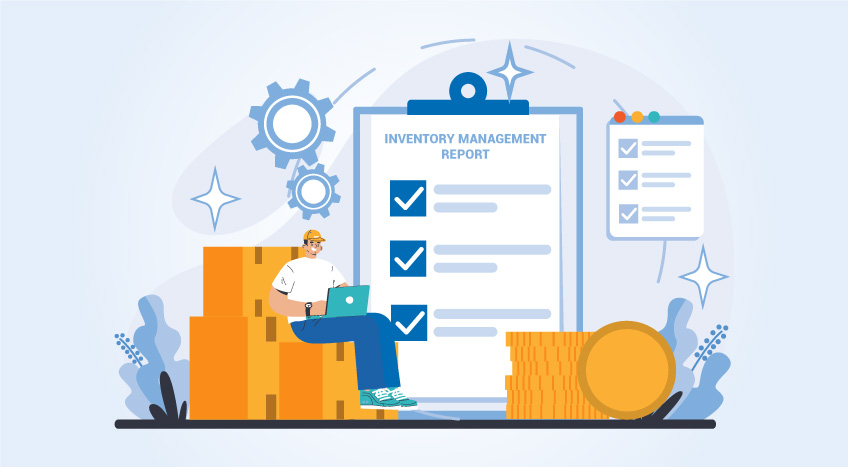It has been observed that close to one-third of small businesses stop operations within their first two years. A common culprit behind their fall is their failure to handle their expanding operations. Inventory management is one of the operations that's often overlooked or not handled effectively.
As a business grows, its inventory will likely grow, requiring painstaking attention to its management. When it is not managed effectively, it leads to damage or loss of inventory, delay, or failure in customer order fulfillment. All of this results in the loss of the business's reputation, and eventually its downfall.
If you don’t want your small business to have a similar fate, one of the first things you should work on is proper inventory management.
Do you have enough stock to meet your customer demands? Do you have a proper system to replenish your stock at the right time automatically? Can you make almost accurate forecasts of customer demands to fulfill all orders without any hassles? The answer to these questions lies in inventory management.
In this blog, we have shed light on key tips to better manage your inventory and increase the visibility and profitability of your business.
#1 Choosing the right inventory method
The right inventory metro should add value to your bottom line. If your business deals in perishable products, opt for the First On First Out (FIFO) method, wherein the inventory you first receive in your warehouse leaves the first.
If you want to reduce your inventory carrying and operating expenses, go for the Just in Time (JIT) inventory method. Here, you only hold as much inventory as you have ordered, having only a little stock in your warehouse.
When you choose the right inventory management software that suits the nature and goals of your business, you will have an easier time managing your inventory.
#2 Making almost accurate forecasts of demands
The key for any business (small or big) to succeed is to identify its sales opportunities and make the most of them. Managing your inventory properly through accurate demand forecasting helps you to do this.
Using the right technology and tools to make almost accurate forecasts based on historical patterns, market trends, seasonal demands, and other data can help you procure the right quantity of inventory. This way, you will not deal with any unpleasant surprises even when you face unusually high customer demands during festive or holiday seasons.
#3 Making an ABC analysis of your inventory
Categorizing inventory into high, medium and low-value is one of the first inventory management tips that small businesses should follow. This is how the ABC categorization should be done on your inventory:
- High-value items that contribute to 80% of your profitability are classified as Category A
- Medium-value items that contribute to 15% of your profitability are classified as Category B
- Low-value items that contribute to only 5% of your profitability are classified as Category C
This categorization helps you manage your inventory accordingly. It gives you ideas to sell your low-value stock quickly to avoid going obsolete or damaged.
#4 Conducting frequent audits and tracking inventory
The quality of your stock should be top-notch at all times. This is where a quality control team can help ensure that your inventory is of high standard, always.
Once the quality is ensured, track the inventory throughout its supply chain cycle. This helps in successful order fulfillment. You can also automate this by using inventory management software such as TallyPrime which comes with an auto-replenishment feature.
Auditing your inventory to check the accuracy of your entries, the quality of your stock, and the rate of successful order fulfillment can help find errors and thus resolve them in time. Clean audit reports add more credibility to your business and hence increase your chance of profitability.
#5 Reducing inventory costs through drop shipping
Drop shipping is a smart inventory management technique for small businesses that don’t have a huge budget to spend on warehouse management. Here, you build a strong partnership with a drop shipping partner. Your supplier sends the stock to this partner, and you move the products from the partner to your customer when you receive orders.
In this case, you don’t have to incur warehouse costs, carrying costs, and other operational costs related to inventory. However, success depends heavily on your ability to find a good drop shipping partner.
- Using the right technology to manage and track inventory
All of the inventory management tips we explained above involve the right software. According to experts, small businesses shouldn’t shy away from investing in good inventory management software at any cost.
Sophisticated software tools come with different features such as barcodes for easy scanning and tracking of inventory, real-time tracking, automatic replenishment based on economic order quantity, warehouse layout, and maintenance, and more.
Bottom line
As a small business owner, you have to spend a lot of time establishing your brand and earning a good reputation from your customers. Proper inventory management is a huge step in backing these efforts.
With the use of the right software and best practices, you can make the most of your sales transactions and boost your bottom line, supercharging your business's success.
These inventory management tips help you save time and effort, minimizing human errors and improving efficiency.
If you are looking for an inventory management tool that streamlines your inventory operations, TallyPrime is an excellent choice. To know about its features and pricing, check the website here.










